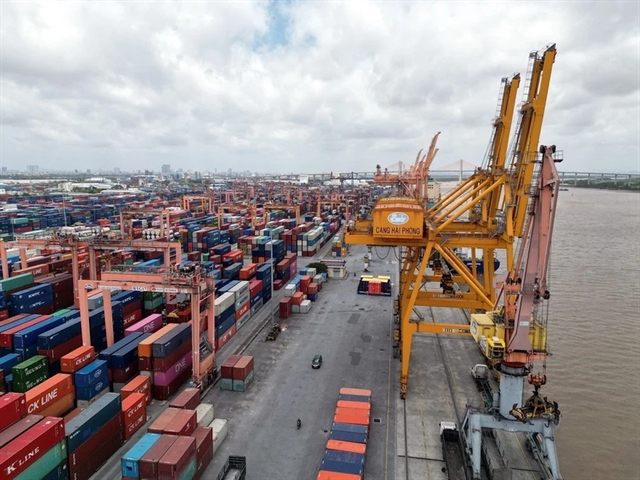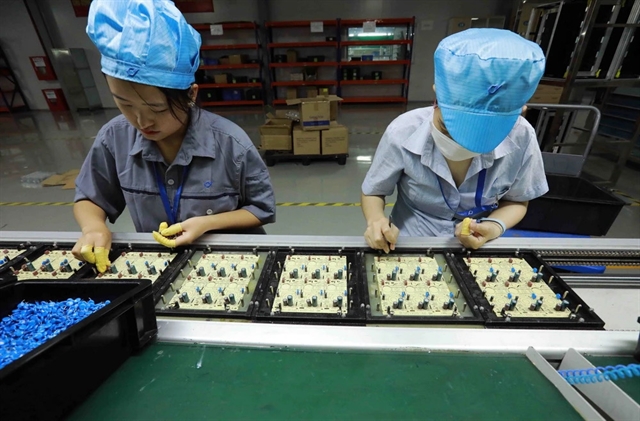 Society
Society


|
| Hải Phòng sets the goal of becoming a leading seaport city in the country by 2030, and a major seaport hub in the region and globally by 2050. — VNA/VNS Photo Tuấn Anh |
HẢI PHÒNG — Deputy Prime Minister Trần Hồng Hà has recently signed a decision approving the new master plan for Hải Phòng City, with the northeastern city evolving into a major seaport hub in the region and globally, anchored by three key pillars of development.
The Hải Phòng City’s master plan, spanning from 2021 to 2030 with a vision to 2050, outlines the city's development strategy based on three key pillars, including seaport and logistics services; a green, smart, and modern industrial sector; and the establishment of an international beach tourism centre.
With an anticipated population of approximately 4.5 million people, Hải Phòng aims to achieve a high level of development, positioning itself among the foremost cities in Asia and the world.
By 2030, the city sets the goal of becoming a leading seaport city in the country, taking the lead in industrialisation, modernisation, and digital transformation.
The average annual growth rate of the Gross Regional Domestic Product (GRDP) during the period 2021-2030 is targeted to be around 13.5 per cent.
In terms of economy, the contribution of Hải Phòng's GRDP to the national Gross Domestic Product (GDP) is expected to reach about 6.8 per cent by 2030. The average annual growth rate of the GRDP is projected to be around 13.5 per cent. The per capita GRDP is expected to reach around VNĐ558 million, equivalent to approximately US$21,700.
In terms of social and cultural aspects, Hải Phòng aims to maintain a Human Development Index (HDI) ranking among the top five cities and provinces in the country. The rate of trained labour with degrees or certificates is targeted at 52 per cent, the poverty rate is expected to be below 0.1 per cent, and urban unemployment is projected to be below 3 per cent.
Regarding the environment, Hải Phòng aims to achieve 100 per cent clean water supply for its population and 100 per cent collection and treatment of household solid waste.
In terms of spatial planning and infrastructure, the city’s urbanisation rate is targeted to be around 74-76 per cent, meeting the criteria of a special type of urban area.
The city is transitioning its growth model towards green growth, circular economy based on science and technology, digital and technological applications, and green and sustainable infrastructure development.
Citizens will enjoy high-quality social services, a sustainable social welfare system, diverse and professional social support services that promptly assist and protect vulnerable individuals.
In the new master plan, Hải Phòng prioritises key sectors playing a leading role in the city's economic growth, including electronics and information technology products; seaport and logistics services; and commerce. The goal is for these three sectors to account for approximately 55-60 per cent of the added value in the city by 2030.
The city encourages sectors with promising development prospects such as the digital economy, real estate business, financial services, healthcare services, and high-quality education and training while maintaining reasonable, efficient, and sustainable development in sectors that leverage the city's traditional strengths, such as machinery and equipment manufacturing, plastics and rubber processing, and shipbuilding.
Economic pillars
The construction industry continues to play a pivotal role in Hải Phòng's economy.
The city is determined to develop a modern, high-tech with low greenhouse gas emissions industry. It actively participates in the global production network and is ready to engage in the national defence industrial production chain when necessary.
Hải Phòng also aims to make a breakthrough in enhancing productivity, quality, and competitiveness of industrial products, focusing on the development of modern industries with strengths in mechanical engineering, transportation mechanics, and electronics. The city prioritises the development of new industries such as chips, semiconductors, robotics, environmental industry, renewable energy, and new materials.

|
| Workers assembly electronic components for the printing industry at Taiwan-invested Chee Yuen Vietnam Electronic Technology Company Limited in An Dương Industrial Zone in Hải Phòng City. — VNA/VNS Photo Vũ Sinh |
Efforts are being made to establish a coastal economic zone in the south of Hải Phòng and to build a support centre for industrial development in the Red River Delta region.
The goal is to transform Hải Phòng into a modern international logistics hub by investing in a sustainable, smart, and modern logistics system, promoting e-commerce, and creating commodity trading platforms and exhibition areas.
New commercial and financial centres are being developed, along with commercial service centres linked to services at Cát Bi and Tiên Lãng airports, and wholesale markets are to be established in Đồ Sơn, Thủy Nguyên, Vĩnh Bảo, Kiến Thụy, An Lão wards.
Hải Phòng is focusing on exploiting the tourism potential of the Cát Bà-Đồ Sơn coastal areas, connecting with localities in the Red River Delta region, aiming to build Hải Phòng into a tourism centre connecting the region and the world.
Chairman of the municipal People's Committee Nguyễn Văn Tùng said that the city is promoting studies on sustainable marine economic development associated with the safeguard of sovereignty over sea and islands, national defence and security.
In addition, the city will continue to direct relevant units to research, manage and effectively exploit marine resources, study and apply new technologies in the development of important marine economic sectors of the city. — VNS